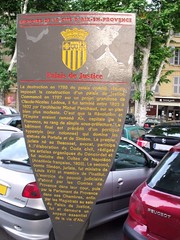Parlement de Provence
Parlement de Provence
(1501-1785)
place, court, and regional legislative and judicial body (1501-1785)
Commemorated on 2 plaques
Palais de Justice La destruction en 1785 du palais comtal, vétuste, imposait la construction d'un palais de justice. Commencé en 1787 sur en projet grandiose de Claude-Nicolas Ledoux, il fut terminé entre 1822 à 1833 par l'architecte Michel Penchaud, sur un plan bien plus modeste. C'est que la Révolution et l'Empire avaient ramené Aix, capitale de la Provence, au rang de simple sous-préfecture. Le bâtiment final est précédé d'un portique hypostyle (sur colonnes) qui domine les statues de Portalis et de Siméon. Le premier, juriste né au Beausset avocat, participa à l'élaboration du Code civil, rédigea les articles organiques du Concordat et fut ministre des Cultes de Napoléon (Académie française, 1803). Le second, comte Siméon, juriste, fut ministre de Louis XVIII et membre de l'Institut. L'exercise du pouvoir judiciaire, d'abord par les Comtes de Provence dans leur cour , puis par le Parlement de Provence dans ses Chambres, enfin par les Magistrats au sein du Palais de Justice, fut et demeure un aspect essentiel de la vie d'Aix.
English translation: Palace of Justice The destruction in 1785 of the old Comtal Palace required the construction of a courthouse. Started in 1787 on a grand project by Claude-Nicolas Ledoux, it was completed between 1822 and 1833 by architect Michel Penchaud, on a much more modest level. The Revolution and the Empire had brought Aix, the capital of Provence, to the rank of a mere sub-prefecture. The final building is preceded by a hypostyl portico (on columns) that dominates the statues of Portalis and Simeon. The first, a lawyer born at the Beausset lawyer, participated in the drafting of the Civil Code, drafted the organic articles of the Concordat and was minister of the Cults of Napoleon (Académie française, 1803). The second, Count Siméon, a lawyer, was minister of Louis XVIII and a member of the Institute. The exercise of judicial power, first by the Counts of Provence in their courtyard, then by the Parliament of Provence in its Chambers, and finally by the Magistrates in the Palais de Justice, was and remains an essential aspect of Aix's life. [AWS Translate]
Le Palais de Justice, Place de Verdun, Aix-en-Provence, France where it sited
Palais des Comtes de Provence Ici se dressait jusqu'en 1785 le palais des Comtes de Provence. Remarquable témoignage des temps, il reliait l'Antique et la Renaissance dans un complexe assemlage architectural. Le palais était solidement assis sur les deux tours romaines de la Voie Aurélienne menant à Rome (aujourd'hui rue d'Italie). Le Moyen Age les comtes de Provence et leur ville. Le Roi René, au milieu 15e siècle y adjoint un corps de bâtiment dont la façade présentait un agencement symétrique, ouvert d'une galerie, et dont la haute toiture aux tuiles vernissées lui était inspirée peut-étre de l'Anjou. Les comtes de Provence y étaient entourés de leur cour et de leurs administrations. Elles y furent remplacées par le Parlement de Provence et ses aprés le rattachement de la Provence à la France en 1481.
English translation: Palace of the Counts of Provence Here stood until 1785 the Palace of the Counts of Provence. Remarkable testimony of time, he connected the Antique and the Renaissance in an architectural complex. The palace was firmly seated on the two Roman towers of the Aurelian Way leading to Rome (now rue d'Italie). The Middle Ages the Counts of Provence and their city. King René, in the middle of the 15th century, added a building body with a symmetrical façade, opened by a gallery, and whose high roof with varnished tiles was perhaps inspired by the Anjou. The Counts of Provence were surrounded by their court and administrations. They were replaced there by the Parliament of Provence and its successor to France in 1481. [AWS Translate]
Place de Verdun - Rue de Mondar, Aix-en-Provence, France where it sited


